HALIFAX — An inquiry into the Nova Scotia mass shooting heard Tuesday from Indigenous residents who complained about the RCMP's failure to issue timely warnings as the killer passed near two First Nations during his 13-hour rampage.
The inquiry has heard that late on the night of April 18, 2020, the RCMP started issuing alerts via Twitter, but those messages did not mention that an active shooter was on the loose — a warning that wasn't issued until 8 a.m. the next day.
At that point, the killer was still at large, disguised as a Mountie and driving a car that look exactly like a marked RCMP cruiser.
Cheryl Copage-Gehue, a member of the Sipekne’katik First Nation, said two of the killer's 22 victims — a Mountie and a young man on an errand — were murdered later that morning near the Indigenous community, also known as Indian Brook.
Residents of the First Nation, about 65 kilometres north of Halifax, don't use Twitter, Copage-Gehue said during a discussion described as a talking circle.
"They're lucky if they're on Facebook," said Copage-Gehue, an adviser on Indigenous issues for the Halifax Regional Municipality.
"They don't go on Twitter, Instagram or any other mechanism like that. We weren't really getting any advisory notifications. Our community members were out, driving around, going to Tim Hortons, getting coffees."
Copage-Gehue said she was among those on the road that day.
"Everybody was in such a vulnerable situation," she told the inquiry, adding that her First Nation has since set up its own emergency alert system.
Luke Markie, who works for the security service that patrols Millbrook First Nation, says that at one point the killer briefly stopped his vehicle at a gas bar in the community, but most residents were unaware of the danger.
"I had no idea that something had happened so close to my community," he said. "I had no idea that this person was sill at large .... We had people going in and out of that gas bar."
He said that even though he works closely with the RCMP, he learned about the dangerous fugitive from a family friend.
"I could have stopped to talk to this guy thinking he was a police officer," Markie said. "I might not be here today if he rolled into my community."
Jerid Watton, a member of the Glooscap First Nation, said the RCMP's decision to use Twitter was a bad call.
"We heard from many of our community members that this wasn't helpful," he said. "This wasn't good enough for them. They still felt like they were in danger when they found out this way."
After the killer was shot dead by two RCMP officers at a gas station north of Halifax, the RCMP faced intense criticism for failing to use the Alert Ready system to warn Nova Scotians about a killer on the loose.
The system has long been used by police to issue Amber Alerts about child abductions. It can also be used to issue other intrusive public warnings through radio, TV and smartphones.
The Mounties, however, have repeatedly said Alert Ready was not part of their "tool box" at the time of the shootings, though the police force was in the process of preparing such an alert when the gunman was killed.
Previously released evidence has confirmed senior RCMP officers were worried that a broader public alert could have put officers in danger by causing a panic. The Mounties have also suggested that 911 operators could have been overwhelmed by callers seeking information.Â
On April 30, 2021, more than a year after the mass shooting, the Nova Scotia RCMP signed an agreement authorizing the Mounties to issue their own alerts through the Alert Ready system.Â
This report by The Canadian Press was first published Sept. 13, 2022.
Michael MacDonald, The Canadian Press




